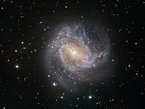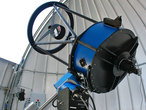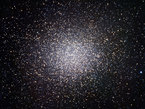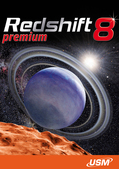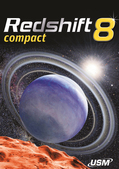TRAPPIST
New National Telescope at La Silla
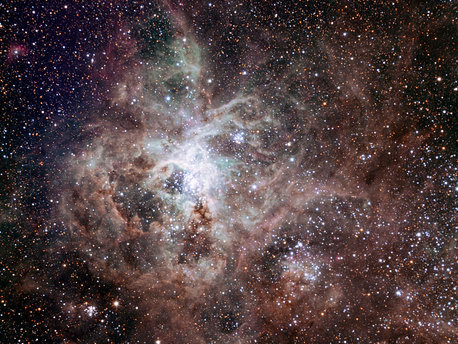 © TRAPPIST/E. Jehin/ESO
|
This first light image of the TRAPPIST national telescope at La Silla shows the Tarantula Nebula, located in the Large Magellanic Cloud (LMC) — one of the galaxies closest to us. Also known as 30 Doradus or NGC 2070, the nebula owes its name to the arrangement of bright patches that somewhat resembles the legs of a tarantula. Taking the name of one of the biggest spiders on Earth is very fitting in view of the gigantic proportions of this celestial nebula — it measures nearly 1000 light-years across! Its proximity, the favourable inclination of the LMC, and the absence of intervening dust make this nebula one of the best laboratories to help understand the formation of massive stars better. The image was made from data obtained through three filters (B, V and R) and the field of view is about 20 arcminutes across.
“Terrestrial planets similar to our Earth are obvious targets for the search for life outside the Solar System, while comets are suspected to have played an important role in the appearance and development of life on our planet,” adds his colleague Emmanuël Jehin, who leads the cometary part of the project.
TRAPPIST will detect and characterise exoplanets by making high precision measurements of “brightness dips” that might possibly be caused by exoplanet transits. During such a transit, the observed brightness of the star decreases slightly because the planet blocks a part of the starlight. The larger the planet, the more of the light is blocked and the more the brightness of the star will decrease [1].
“ESO’s La Silla Observatory on the outskirts of the Atacama Desert is certainly one of the best astronomical sites in the world,” says Gillon. “And because it is already home to two superb exoplanet hunters, we couldn’t have found a better place to install our robotic telescope.”
The astronomers behind the TRAPPIST initiative will work very closely with the teams using HARPS on the 3.6-metre telescope and CORALIE attached to the Swiss 1.2-metre Leonhard Euler Telescope, both at La Silla. TRAPPIST is a collaboration between the University of Liège and the Geneva Observatory, Switzerland. The telescope is installed in the building that housed the old Swiss T70 telescope. Thanks to this collaboration, the whole project is on a fast track: it took only two years between taking the decision to build and first light.
TRAPPIST will also be used for the study of southern comets. To this aim, the telescope is equipped with special large, high quality cometary filters, allowing astronomers to study regularly and in detail the ejection of several types of molecules by comets during their journey around the Sun.
“With dozens of comets observed each year, this will provide us with a unique dataset, bringing important information about their nature,” says Jehin.
TRAPPIST is a lightweight 0.6-metre robotic telescope, fully automated and moving precisely across the sky at a high speed. The observing programme is prepared in advance and the telescope can perform a full night of observations unattended. A meteorological station monitors the weather continuously and decides to close the dome if necessary.
Notes
[1] A planetary transit occurs when a celestial body passes in front of its host star and blocks some of the star’s light. This type of eclipse causes changes in the apparent brightness of the star and enables the planet’s diameter to be measured. Combined with radial velocity measurements, it is also possible to deduce the mass and, hence, the density of the planet.
Source: ESO - European Southern Observatory
TRAPPIST
New National Telescope at La Silla
 © TRAPPIST/E. Jehin/ESO
|
This first light image of the TRAPPIST national telescope at La Silla shows the Tarantula Nebula, located in the Large Magellanic Cloud (LMC) — one of the galaxies closest to us. Also known as 30 Doradus or NGC 2070, the nebula owes its name to the arrangement of bright patches that somewhat resembles the legs of a tarantula. Taking the name of one of the biggest spiders on Earth is very fitting in view of the gigantic proportions of this celestial nebula — it measures nearly 1000 light-years across! Its proximity, the favourable inclination of the LMC, and the absence of intervening dust make this nebula one of the best laboratories to help understand the formation of massive stars better. The image was made from data obtained through three filters (B, V and R) and the field of view is about 20 arcminutes across.
“Terrestrial planets similar to our Earth are obvious targets for the search for life outside the Solar System, while comets are suspected to have played an important role in the appearance and development of life on our planet,” adds his colleague Emmanuël Jehin, who leads the cometary part of the project.
TRAPPIST will detect and characterise exoplanets by making high precision measurements of “brightness dips” that might possibly be caused by exoplanet transits. During such a transit, the observed brightness of the star decreases slightly because the planet blocks a part of the starlight. The larger the planet, the more of the light is blocked and the more the brightness of the star will decrease [1].
“ESO’s La Silla Observatory on the outskirts of the Atacama Desert is certainly one of the best astronomical sites in the world,” says Gillon. “And because it is already home to two superb exoplanet hunters, we couldn’t have found a better place to install our robotic telescope.”
The astronomers behind the TRAPPIST initiative will work very closely with the teams using HARPS on the 3.6-metre telescope and CORALIE attached to the Swiss 1.2-metre Leonhard Euler Telescope, both at La Silla. TRAPPIST is a collaboration between the University of Liège and the Geneva Observatory, Switzerland. The telescope is installed in the building that housed the old Swiss T70 telescope. Thanks to this collaboration, the whole project is on a fast track: it took only two years between taking the decision to build and first light.
TRAPPIST will also be used for the study of southern comets. To this aim, the telescope is equipped with special large, high quality cometary filters, allowing astronomers to study regularly and in detail the ejection of several types of molecules by comets during their journey around the Sun.
“With dozens of comets observed each year, this will provide us with a unique dataset, bringing important information about their nature,” says Jehin.
TRAPPIST is a lightweight 0.6-metre robotic telescope, fully automated and moving precisely across the sky at a high speed. The observing programme is prepared in advance and the telescope can perform a full night of observations unattended. A meteorological station monitors the weather continuously and decides to close the dome if necessary.
Notes
[1] A planetary transit occurs when a celestial body passes in front of its host star and blocks some of the star’s light. This type of eclipse causes changes in the apparent brightness of the star and enables the planet’s diameter to be measured. Combined with radial velocity measurements, it is also possible to deduce the mass and, hence, the density of the planet.
Source: ESO - European Southern Observatory

